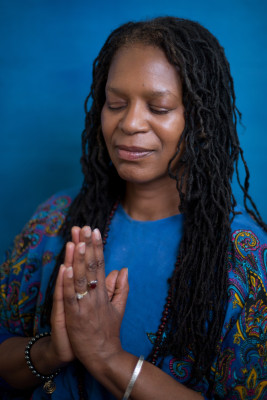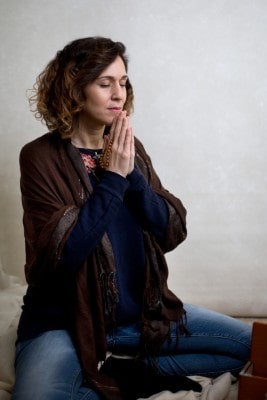Through this blog, The Yogis Say, I like to take the highest spiritual teachings and deliver them in a way that is easy to understand and use in daily life. Sometimes, though, there’s just no substitute for a real pro. Swami Kriyananda, the founder of Ananda, was the direct disciple of Paramhansa Yogananda, author of Autobiography of a Yogi. Here are 10 tips from Swami Kriyananda’s book, Meditation for Starters, that can help improve your meditation practice no matter what path you are on or technique you use:
1. “To help break a lifelong habit of restlessness, try simplifying your life outwardly and reducing the number of personal desires.”
I have found it helpful to try going without something once in a while, such as a short fast or trying to avoid spending much money for a time. This helps me to realize how freeing it is and motivates me to reduce my desires.
 2. “The essential attitude for correct meditation is one of listening. The mind must be kept receptive.”
2. “The essential attitude for correct meditation is one of listening. The mind must be kept receptive.”
One technique for listening I’ve done is meditating outside in the morning (if it’s not too cold), listening to all the sounds around me and losing myself in them. Then after a while, I turn my focus inward and try to forget the outward sounds and listen as if God were about to speak to me.
3. “Meditation is the opposite of imposing your will on the world.”
Through my practice of meditation I’ve come to see that when I meditate more, I’m less likely to get frustrated and wish things were different. It’s easier for me to go with the flow and focus more on improving my attitude rather than the situation. Meditation is the practice of letting the physical world go by on it’s own while I choose to be still and focus on the spirit.
4. “To meditate, will power is necessary, but the will should be used to deepen your enjoyment of relaxation.”
There’s a fine line between using your will to focus your mind in meditation, and using your will to force yourself not to move or think. When you try too hard, it causes tension, and deeper states cannot be attained without deep relaxation.
5. “Without relaxation—of mind as well as of body—you won’t be able to concentrate deeply. And you won’t ever become truly receptive.”
When you are not relaxed, your mind focuses on the outside world and the uncomfortable feeling of tension, so it can’t hear the whispers of the spirit.
6. “The more deeply conscious and receptive you become, the deeper and more satisfying your meditations.”
Once you learn how to relax and focus your mind inwardly, you’ll find you enjoy your meditations more, and it will be easier to keep up a regular practice. Eventually, you won’t be able to imagine life without it.
 7. “The more you can hold your concentration at the point between the eyebrows, the sooner superconscious experiences will come to you.”
7. “The more you can hold your concentration at the point between the eyebrows, the sooner superconscious experiences will come to you.”
Focusing between the eyebrows, or gazing slightly upward behind your closed eyelids, will help to raise your consciousness as you meditate (or any time, really), and will keep your meditations from turning into a planning session for your day.
8. “Gaze deeply into, and behind, the darkness you behold at the point between the eyebrows when your eyes are closed.”
When you go deep into meditation with your eyes focused between the eyebrows, eventually you will see the spiritual eye, which looks like a five-pointed star in a blue field with a gold ring around it.
9. “Listen!—not with the ear only, but with your entire being. Feel yourself in sympathetic resonance with the vibrations of inner silence.”
If you can listen deeply enough, you will begin to hear the inner sounds of the chakras.
10. “Visualize your heart’s feelings rising upward in devotion toward the spiritual eye, the point between the eyebrows—the gateway to Infinity.”
Without devotion, whatever form that devotion takes, you will not be able to advance spiritually. Devotion is necessary to take your meditations to the highest level. It can be difficult to feel devotion to a formless God, so you may want to choose a form that appeals to you, such as Jesus, Krishna, or Divine Mother. Keep in mind that the goal of meditation is to be closer to that Being.

15 Comments
Is any form of music recommended? I have practiced ananda energization technique but no music was recommended.
Thanks for the article.
Hi Nirupma,
Swami Kriyananda has actually written many chants for singing or listening to before meditation: https://www.crystalclarity.com/music.php. If you are following Paramhansa Yogananda’s path, I would recommend only listening or chanting to his or Swami Kriyananda’s music before meditation, because this will help you to tune into their vibration.
If you are on another path or don’t have a path, they are still useful, but you could also chant any simple Indian chant or listen to any uplifting spiritual music.
Blessings,
Radhika
Thank you, for your reply.
Regards.
Lovely. Thank you for sharing.
These are some really good tips.
“To meditate, will power is necessary, but the will should be used to deepen your enjoyment of relaxation.”
This is a kind of zen-like paradox but meditators will understand it. It take a conscious intention to relax at first because our will and attention is usually in service of restlessness by default.
Great
love to read this articles.meditation tips is provided in it in very simple way thanks for sharing.
Excellent post!! Thank you!